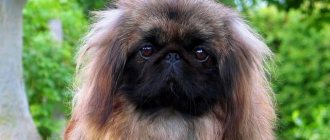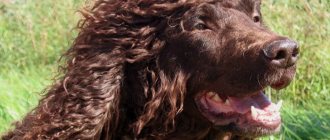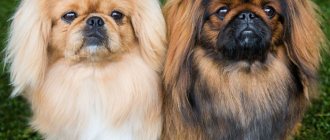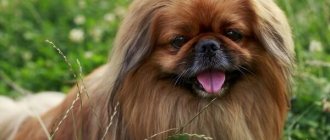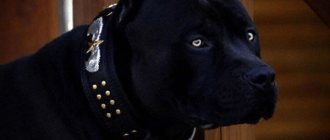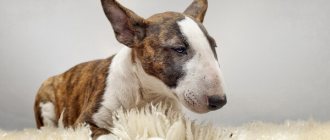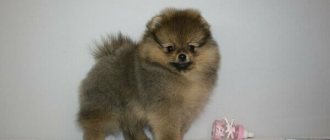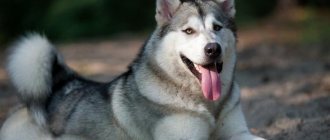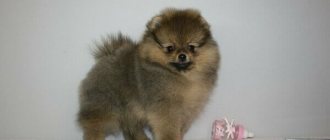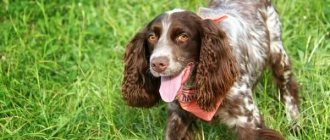Pit bull terriers, which have become almost synonymous with anger and aggression, are gaining more and more popularity.
Despite the mixed attitude of society, these dogs are characterized more as loyal friends and faithful companions than as ferocious and unbalanced dogs.
Those who love pit bulls, but cannot have such a pet because they live in a small apartment, should pay attention to their smaller copy - the mini pit bull.
Description of the breed and what it looks like in the photo
Mini pit bulls are dogs with a strong, stocky build, which makes them look bulky and powerful.
This build makes them unable to develop great speed, but in battle they compensate for this with the death grip of their powerful jaw..
- The body is rectangular, muscular, the back is straight and short with a smooth transition into a short loin. The chest is wide and voluminous, the ribs are rounded and arched.
- The belly is tucked in and connected to the chest by an almost straight line. The neck is short and thick, tapering towards the head, and the scruff is clearly defined.
- The head is wide and large, in the shape of a blunt wedge, proportional to the body. The skull is flat on top and rounded on the sides.
- Cheekbones and cheeks are emphasized and slightly saggy. If the animal grins or frowns, many skin folds form on the head. The size of the muzzle, slightly tapering towards the nose, is approximately equal to the skull, the lobe is black or colored to match the coat.
- The eyes are small, almond-shaped or round, set deep. The ears are set high and close to each other, erect at a natural length with the tips hanging down, but can be cropped.
- The limbs are short and powerful. The front ones are straight and strong, the shoulder blades are laid back and connect to the shoulders at a right angle, the rear ones are straight, set parallel and wide.
- The tail is short, set low, saber-shaped, not curled, not docked.
- The coat of dwarf pit bulls is short, thick and shiny, without signs of wavy, and lies tightly to the body.
Dimensions, weight and other distinctive features
- Height . Males - from 46 to 53 cm. Females - from 43 to 51 cm
- Weight . Males - 16-27 kg. Females - 14-23 kg.
- Head . Medium in size, proportional to the body, shaped like a rectangle. The skull is moderately wide and somewhat flattened in the frontal region, the cheekbones are pronounced. The jaws are well developed, strong and strong.
- Muzzle . Square in shape, voluminous and quite wide.
- Ears . Semi-erect or rose-shaped, set high. As a rule, pit bulls' ears are cropped.
- Eyes . Low set, round or almond shaped. Eye color is usually brown in various shades, sometimes it can be light amber.
- Neck . Strong, dry, well muscled, somewhat widening towards the withers.
- Shoulder blades . Muscular, set askew.
- Back . Slightly sloping towards the tail, quite wide and strong, but not long.
- Rib cage . Sufficient depth and volume.
- Forelegs . Strong, parallel and straight.
- Hind limbs . Strong, with regular angles of articulation and well-defined muscles on somewhat elongated thighs.
- Tail . Short and low set, wider at the base and tapering towards the end. Usually carried either lowered or raised no higher than the line of the spine.
- Wool . Close-lying, rather hard and short with a characteristic shine, no undercoat.
The body type of a dog depends on what type it belongs to: bulldog, terrier or intermediate, which is considered the standard for this breed.
Gray bulldog-type pitbulls look more massive and muscular, they have relatively wide heads and muzzles and may even have an undershot.
Terrier-type dogs are relatively tall-legged and lighter, and their heads and muzzles are usually narrowed.
Origin story. Marriage or breed?
Pit bull terriers are one of the most popular dog breeds in the United States, which have become the unofficial symbol of this country . Moreover, a country where at the beginning of the 19th century. The ancestors of these dogs were bred - Staffordshire Terriers - in Great Britain.
It was there that dog fighting flourished, creating a need for fierce and fearless dogs, stubbornly pursuing victory. After the ban on such bloody entertainment, representatives of this breed began to be used as simple guard dogs.
After some pit bull terriers arrived in the United States with immigrants, American breeders and breeders began improving the breed, paying maximum attention to the psyche of its representatives, trying to make them softer and kinder.
The next, even more daring, step of the breeders was the creation of a variety of pit bull terriers, distinguished not only by their gentle disposition, but also by their more compact size..
Painstaking work on crossing pit bulls with Patterdale terriers was crowned with success in 1990 - it was then that mini pit bulls were bred, which became lighter and shorter in stature, but retained strength, endurance and energy.
These dogs have not received official recognition from the FCI..
Standard colors with photos
Since more than one canine federation still does not recognize this breed, the pit bull does not have strict standards for appearance. Therefore, each color from the general variety (except marble) is considered standard.
The merle color is obtained thanks to the M gene, bred by artificial selection of different breeds to obtain a new color.
Pitbull colors can be roughly divided into three categories:
- brindle,
- solid,
- spotted.
Merle
The color appeared relatively recently and immediately caused a lot of disagreement among breed connoisseurs. Merle is a diluent gene. By diluting the paint gene, it makes it possible to synthesize colors that are not typical for this breed. But the problem is that pigment cells are created along with the same set of cells from which the nervous system develops. Therefore, along with the updated color, the dog can also receive:
- eye development defect,
- complete deafness,
- birth of offspring premature, malformed or sterile,
- other neurological, immune and mental disorders.
The peculiarity of the color is the unevenly colored coat in the form of less or darker areas of the same color. Crossing two pets with this gene is strictly prohibited. People are not just born with such a gene.
If a dog has a color defect, it means there are problems with the nervous system.
brindle
It occurs quite often. Is a natural color. It consists of stripes that cover the dog’s entire body from bottom to top, or only spots, or, on the contrary, everything except spots.
Black
It is often confused with blue and vice versa. This happens due to the person’s inexperience or the weak intensity of the black color. People have ambivalent attitudes towards this color: some do not accept it as the standard color of this breed, others say that black pit bulls are more prone to aggression and less adequate than others. This is mistake. The color of the coat has nothing to do with the aggressiveness of the animal. Black pit bulls, although particularly fearsome in appearance, are some of the most loving dogs in the world. This is probably why this color is especially popular among dog breeders from the USA.
To read: Introducing one of the fluffiest breeds of Siberian cats: characteristics and maintenance rules
Blue
Another name is blue. One of the rarest colors of this breed. But the most popular among those who want to buy a pit bull. Great demand has led to the fact that unscrupulous breeders, seeing the client’s incompetence, sell him a black dog under the guise of the desired blue color.
White
Entirely, with the exception of the muzzle, white. There are varieties of color that are lighter or, conversely, closer to gray. White is also possible in the form of spots and even as a third color.
Chocolate
There are five varieties:
- chocolate,
- dark chocolate,
- light chocolate (cocoa),
- chocolate white,
- chocolate and tan.
Leopard
Carriers of this color are more often called spotted Albanian pit bulls.
This is the same American pit bull terrier, but with a leopard color. This is the impact of Merle.
Of course, the color is not accepted by the official standard and, like any marble color, it is unsafe. This fact does not prevent such dogs from being actively bred over the hill, because they are in demand there.
Such breeds should not exist, as most dog handlers and zoologists believe.
Having no analogues, the only specimen of the Albanian pit bull is considered to be a dog named Titus. He was bred and raised in the USA. It has the shape of a pit bull and the coloring of a cheetah.
Grey
In other words, fawn. The color is like white sand. It can also be compared to the tan and red coloration. If you arrange these colors in order of brightness, it will represent the following:
- pale yellow,
- ginger,
- red.
teak
Teak refers to small spots (specks) on the white areas of a pet's coat. The Pitbull's base color (no white) is mottled. However, it will not be possible to see it, since it is visible only on white fur. Examples include Dalmatians or English Setters; they also have markings.
Teak (mottling) and Merle, different colors. It's easy to confuse them.
Character traits
Mini pit bulls can be described as good-natured, playful, loyal to their owner, but at the same time stubborn, wayward and strong-willed dogs.
They are strong and fearless and would make excellent watchdogs, but they are too friendly towards everyone, seeing strangers only as potential friends..
Moreover, if the owner or one of the family members is in danger, the mini pit bull will selflessly protect them, even if the enemy is much larger and larger than him.
Breeders have made a lot of efforts to get rid of the aggression towards other animals inherent in representatives of this breed, and they partially succeeded - these dogs get along with other pets easier than standard pit bulls, but they are still treated aggressively towards strangers.
Unlike standard pit bulls, the miniature variety, although highly active, is still calmer and more patient and more similar to other companion dogs..
Expert opinion
Kozhevin Semyon Kirillovich
Expert dog handler.
Miniature pit bulls are intelligent, trainable, and always eager to please their owner. They value care and need it, love communication and attention. Training is significantly complicated by their stubbornness and willfulness, therefore it is important to show persistence and show that the owner is an unconditional leader who must be respected and obeyed. Socialization is extremely important for these dogs; without it, they can grow up aggressive.
Advantages and disadvantages
Advantages of mini pit bull terriers:
- friendliness;
- mind;
- ability to learn;
- courage;
- devotion;
- love for children;
- moderate shedding.
The disadvantages of the breed include:
- stubbornness;
- aggression towards other animals;
- the need for competent education and socialization.
In addition, these dogs are not suitable for street keeping or use as guard dogs.
Color variations
The coat of this breed can come in a variety of colors, be a solid color, or have lighter and white markings on the paws, neck and chest.
The most common and popular colors black , white and gray .
Dog kennel "Brave Fighter" Pit bull terrier
Take the Attention Test! Find 10 differences! (click right here!)
Find the answer Are you bothered by some problem or question? Enter “Breed” or “Name of the problem” into the form, press Enter and you will find out everything about the issue that interests you.
https://dog-care.ru/porody/pitomniki/sobak-amerikanskiy-pitbulterer-v-moskve.html
| Description: | |
| Contacts: | +7 |
Diet
The diet of mini pit bulls can be based on natural products or industrial food - the choice depends on the dog owner. Both types of nutrition have pros and cons, so it is impossible to say unequivocally which one is better.
Thus, high-quality industrial feed, belonging to the premium, super-premium or holistic class, has a balanced composition enriched with vitamins and minerals, they are easy to use and dose, and can be stored for a long time.
At the same time, in case of an allergy to some component of the feed, a complete change of diet will be necessary.
NOTE!
Representatives of this breed are more suitable for food brands Eukanuba, Probalance, Pro Pac, Hill's, Royal Canin, Go.
Natural food requires more time to prepare food, but allows the owner to independently choose food for the pet and is safer when considering the risk of an allergic reaction.
The natural diet should include:
- offal;
- lean meat;
- veins and cartilage;
- sea fish;
- dairy products;
- vegetables;
- porridge.
It is forbidden to feed mini pit bulls:
- pickles, marinades;
- spicy and fried foods;
- sweets;
- milk;
- bakery and pasta products;
- potatoes.
With this type of nutrition, it is necessary to give the dog a vitamin and mineral complex.
Health and major diseases, life expectancy
The rather heavy build of miniature pit bull terriers causes them to often have problems with the heart and breathing; representatives of this breed often experience shortness of breath, so they have difficulty withstanding hot weather.
In addition, these dogs are susceptible to a number of hereditary pathologies, among which the most often diagnosed:
- heart disease;
- hypothyroidism;
- aortic stenosis;
- hip dysplasia;
- allergic reactions to food, certain medications, and external irritants such as pollen or insect bites.
Experts also say that mini pit bulls are susceptible to helminthiasis, so you need to carefully monitor what your pet eats and not neglect the timely use of anthelmintic drugs.
At the first signs of illness and symptoms of pathology, it is necessary to show the dog to a veterinarian.
The average lifespan of these dogs is 11-13 years.
How are children treated?
Although miniature pit bull terriers choose one owner, they love all family members, and are especially kind to children..
These dogs have a high pain threshold, so they tolerate children’s less-than-cautious attitude, expressed in pulling their ears or tail, easily and are not irritated.
Representatives of this breed are inquisitive and active, so fun and active games with kids bring them pleasure . These dogs become not only friends and nannies for children, but also loyal protectors.
Features of care
Mini pit bulls are dogs intended for home keeping..
They cannot live outside because they are sensitive to frost and heat. At the same time, living in an apartment or house, representatives of this breed need daily active walks.
Wool and bathing
The coat should be brushed weekly with a soft-bristled massage brush. After walks, you need to wash your pet's paws, and you should bathe him completely no more than once every 2-3 months to avoid drying out the hairs.
When bathing, you need to use a shampoo that is suitable for your dog’s coat type and make sure that foam and water do not get into the dog’s ears..
Teeth
To avoid the formation of plaque and tartar, brush your dog’s teeth twice a week with a special brush and toothpaste.
Eyes
Every morning, wipe with a lint-free cloth soaked in boiled water or chamomile infusion, making sure there is no strong souring and increased tearing.
Claws
Trim as it grows, approximately once every 3-4 weeks, with a guillotine nail cutter so as not to touch the living part and blood vessels.
Ears
Wipe weekly with a soft cloth soaked in a special lotion to remove accumulated wax and dust.
Genetics of colors
An important aspect when choosing a pet is color. Dog fur is heterogeneous and consists of different types of hair:
- cover (first layer),
- guard (second layer),
- downy (undercoat).
The guard hair conveys the tone, and the down hair conveys the shade. Pigment controls color. With a lack or absence of it, the hair is colorless. The American Pit Bull Terrier has three color pigments: yellow, brown and black.
The color of both skin and hair can be formed only with the help of the pigment melanin. There are two forms of melanin:
- eumelanin (black, brown color),
- pheomelanin (yellow, orange color).
Colored dogs have different sets of genes in their genotype.
Genes responsible for coloring and their symbols:
- gene C (the body’s ability to create a pigment of any color),
- gene A (distribution of pigment throughout the hair),
- gene B (creation of black pigment),
- c (partial albinism),
- b (formation of brown pigment).
To read: European Shorthair cats: tips for caring for a classic pet
This unusual breed in every sense looks good in any color. She represents strength, courage, devotion and love. And if you are determined to get just such a dog, then don’t let anyone change your decision. It is not the dog that paints the man, but the man who paints the dog. In any case, all responsibility lies with you.
Training and education
During training, you cannot physically punish the dog or shout at it; commands must be pronounced calmly, but firmly and confidently, not allowing it to evade their execution.
It is better if the training takes place in a playful way and immediately after a walk, when the pet is tired enough and will no longer be distracted by external stimuli..
First you need to accustom the puppy to the nickname, calling him by name as often as possible. Afterwards, you should practice the “come to me” command, calling your pet when it is at a distance, but within sight.
Basic and necessary commands for mastering also include the commands “sit” (“lie down”), “no”, “wait” and “place”, and while walking you will need the command “near”.
To make care and maintenance easier, it’s a good idea to master the command “give me your paw” and develop your pet’s endurance.
IMPORTANT!
After each correctly executed command, the pet should be praised and treated with a treat - this helps to consolidate positive associations.
How to choose?
Buying a puppy of this breed from a specialized nursery is not a whim, but a necessity . This is the only way to minimize the risk of acquiring a mixed breed or a sick animal.
In addition, breeders will provide all the necessary information about the parents of the future pet, talk about how to properly care for it and can guarantee that the puppy does not have genetic pathologies or developmental disorders.
You should not rush into choosing a dog and buy the first puppy you like . It is necessary to observe the behavior of children, to understand what character traits are inherent in them.
Thus, apathetic puppies that do not take part in the games of their littermates will most likely grow up calm and even lazy, but curious and active puppies will become energetic and playful dogs and will not lose these qualities even in adulthood.
It is also important to make sure your pet is healthy.
He should not have any rashes or irritations on the skin, a dull coat with traces of dandruff, a bloated belly, excess weight or exhaustion, discharge from the ears or nose, increased tearing or signs of sour eyes.
Pitbull temperament
There is an opinion that the purpose of the American Pit Bull Terrier is to organize dog fights. Many argue that this is perhaps the most aggressive breed. We hasten to reassure you: this opinion is groundless. In fact, the pit bull is a fairly calm and balanced animal that gets along well with other animals, as well as children. In addition, the pit bull breed has the following characteristics:
- dynamism;
- patience;
- energy;
- obedience;
- devotion.
The Pit Bull Terrier is a loyal dog that strives to help its owner in everything. This pet will not cause you problems, but only if you can provide the puppy with exciting leisure time at home from an early age and raise him correctly.
Price range
Miniature Pit Bull Terriers are hybrid and quite rare dogs that were bred just a few decades ago.
The popularity of this breed and the growing demand for its representatives have led to the emergence of a mass of unscrupulous breeders, so you should buy a puppy only in specialized nurseries, of which there are very few in the CIS countries, or order from Europe or the USA.
The cost of a mini pit bull puppy is at least 15 thousand rubles. and increases depending on its class, and in the case of an order from another country, the cost of shipping the dog will be added to this price .
Preparing for the arrival of a puppy in the house
pitbull puppies
Before purchasing a pitbull puppy, you need to prepare for this event.
- Decide on the breed of the dog. Study all the advantages and disadvantages of pit bulls and make your final decision. We also recommend that you decide on the gender of your future pet at this stage.
Note: pit bulls are divided into 2 types: bulldog type and terriers.
- Read information about the care, diet, education and training of pit bull terriers.
- Create comfortable conditions for your puppy to stay in the house. Buy him bedding, bowls, toys, vitamins, etc. Also, don't forget to purchase a leash and muzzle for walking.
- Try to find a trusted seller: this could be a well-known breeder or a specialized nursery.
- Decide immediately on the purpose of purchasing a puppy. If you need a loyal friend, then it is not necessary to buy a puppy with an ideal pedigree. If you want to take part in various exhibitions and competitions, then choose pit bull puppies of pet-, breed- and show class.

